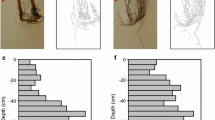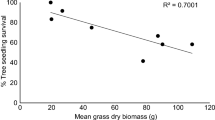Abstract
With the proliferation of old fields and the decline of native grasslands in North America, non-indigenous grasses, which tend to colonize and dominate North American old fields, have become progressively more abundant. These new grasses can differ from native grasses in a number of ways, including root and shoot morphology (e.g., density of root mat, height of shoots), growth phenology (e.g., cool season vs. warm season growth), and plant–soil–water relations due to differences in photosynthetic physiology (C3 vs. C4). Woody plants have been slow to colonize some old fields in the prairie-forest border area of North America and it is hypothesized that non-indigenous grasses may be contributing to the poor establishment success of woody plants in this region, possibly through more intense competition for resources. To test this hypothesis, a multi-factorial field experiment was conducted in which water, nitrogen, and grass functional group (non-indigenous C3 and native C4 species) were manipulated in a study of survival of oak seedlings. The grass type variously affected some of the different growth measurements, however, the effects of grass type on seedling growth were small compared to the effects on seedling survival. The results showed that when grown under dry conditions, seedlings growing in non-indigenous grasses experienced up to a 50% reduction in survival compared to those growing in native grasses under the same conditions. Analyses of root and shoot competition showed that the cause for the reduced survival in the non-indigenous grasses was due primarily to underground processes. The findings confirmed our initial hypothesis that non-indigenous grasses are likely contributing to the poor establishment success of woody plants in these old fields. However, the explanation for the reduced oak seedling survival in non-indigenous grasses does not appear to be due to reduced resource availability since soil water levels did not differ between non-indigenous and native grass plots and other resource levels measured (light, NO3, and NH4) were higher in non-indigenous grass plots under dry conditions. An alternative explanation is that the non-indigenous grasses modify the soil environment in ways that, under dry conditions, are deleterious to emerging oak seedlings. Since current climate projections for the upper Midwest are for hotter and drier summers, the results suggest that the resistance of these old fields to oak encroachment will likely increase in the future.
Similar content being viewed by others

References
S. Archer (1989) ArticleTitleHave southern Texas savannas been converted to woodlands in recent history? Am. Natural 134 545–561 Occurrence Handle10.1086/284996
C.K. Augspurger (1984) ArticleTitleSeedling survival of tropical tree species: interactions of dispersal distancelight gaps, and pathogens Ecology 65 1705–1712
T.M. Barkley (Eds) (1986) Flora of the Great Plains University Press of Kansas LawrenceKansas
M. Bastl P. Kocar K. Prach P. Pysek (1997) The effect of successional age and disturbance on the establishment of alien plants in man-made sites: an experimental approach J.H. Brock M. Wade P. Pysek D. Green (Eds) Plant Invasions: Studies from North America and Europe Backhuys Publishers Leiden, The Netherlands 191–201
M.D. Bertness R. Callaway (1994) ArticleTitlePositive interactions in communities Trends Ecol. Evol 9 191–193
J.D. Bever K.M. Westover J. Antonovics (1997) ArticleTitleIncorporating the soil community into plant population dynamics: the utility of the feedback approach J. Ecol 85 561–573
R.M. Callaway E.T. Aschehoug (2000) ArticleTitleInvasive plants versus their new and old neighbors: a mechanism for exotic invasion Science 290 521–523 Occurrence Handle10.1126/science.290.5491.521 Occurrence Handle11039934
J.M Christian S.D. Wilson (1999) ArticleTitleLong-term ecosystem impacts of an introduced grass in the northern great plains Ecology 80 2397–2407
J.T. Curtis (1959) The Vegetation of Wisconsin University of Wisconsin Press Madison
C.M. D’Antonio P.M. Vitousek (1992) ArticleTitleBiological invasions by exotic grasses, the grass/fire/cyle and global change Annu. Rev. Ecol. System 23 63–87
B.T. Danner A.K. Knapp (2003) ArticleTitleAbiotic constraints on the establishment of Quercus seedlings in grassland Global Change Biol 9 266–275 Occurrence Handle10.1046/j.1365-2486.2003.00574.x
M.A. Davis A. Duke T. Ibsen H. Tran R. Rhodes (1997) ArticleTitleSpatial distribution of Penstemon grandiflorus (Nutt.) and Geomys bursarius in a fragmented oak woodland in MinnesotaUSA Nat. Areas J 17 136–143
M.A. Davis M. Pelsor (2001) ArticleTitleExperimental support for a resource-based mechanistic model of invasiblity Ecol. Lett 4 421–428 Occurrence Handle10.1046/j.1461-0248.2001.00246.x
M.A. Davis K. Thompson J.P. Grime (2001) ArticleTitleCharles S. Elton and the dissociation of invasion ecology from the rest of ecology Div. Distrib 7 97–102 Occurrence Handle10.1046/j.1472-4642.2001.00099.x
M.A. Davis K.J. Wrage P.B. Reich (1998) ArticleTitleCompetition between tree seedlings and herbaceous vegetation: support for a theory of resource supply and demand J. Ecol 86 652–661 Occurrence Handle10.1046/j.1365-2745.1998.00087.x
M.A. Davis K.J. Wrage P.B. Reich M.G. Tjoelker T. Schaeffer C. Muermann (1999) ArticleTitleSurvival, growthand photosynthesis of tree seedlings competing with herbaceous vegetation along a water-light-nitrogen gradient Plant Ecol 145 341–350 Occurrence Handle10.1023/A:1009802211896
R. del Moral (1985) ArticleTitleCompetitive effects on the structure of subalpine meadow communities Can. J. Bot 63 1444–1452
D. de Steven (1991) ArticleTitleExperiments on mechanisms of tree establishment in oldfield succession: seedling survival and growth Ecology 72 1076–1088
G. Ganade V.K. Brown (2002) ArticleTitleSuccession in old pastures of central Amazonia: role of soil fertility and plant litter Ecology 83 743–754
D.S. Gill P.L. Marks (1991) ArticleTitleTree and shrub seedling colonization of old fields in central New York Ecol. Monogr 62 183–205
D.E. Goldberg K.L. Gross (1988) ArticleTitleDisturbance regimes of mid-successional old fields Ecology 69 1677–1688
D.R. Gordon J.M. Welker J.W. Menke K.J. Rice (1989) ArticleTitleCompetition for soil water between annual plants and blue oak (Quercus douglasii) seedlings Oecologia 79 533–541 Occurrence Handle10.1007/BF00378672
S.J. Grayston G.S. Griffith J.L. Mawdsley C.D. Campbell R.D. Bardgett (2001) ArticleTitleAccounting for variability in soil microbial communities of temperate upland grassland ecosystems Soil Biol. Biochem 33 533–551 Occurrence Handle10.1016/S0038-0717(00)00194-2
Grigal D.F., Chamberlain L.M., Finney H.R., Wroblewki D.V. and Gross E.R. 1974. Soils of the Cedar Creek Natural History Area. Miscellaneous Report 123, University of Minnesota Agricultural Experiment Station, St. Paul, Minnesota.
R.J. Hobbs L.J. Huenneke (1992) ArticleTitleDisturbancediversity and invasion: implications for conservation Conserv. Biol 6 324–337 Occurrence Handle10.1046/j.1523-1739.1992.06030324.x
M. Holmgren M. Scheffer M.A. Huston (1997) ArticleTitleThe interplay of facilitation and competition in plant communities Ecology 78 1966–1975
R.S. Inouye T.D. Allison N.C. Johnson (1994) ArticleTitleOld field succession on a Minnesota sand plain: effects of deer and other factors on invasion by trees Bull. Torrey Bot. Club 121 266–276
R.B. Jackson J. Canadell J.R. Ehleringer H.A. Mooney O.E. Sala E.D. Schulze (1996) ArticleTitleA global analysis of root distribution for terrestrial biomes Oecol 108 389–411 Occurrence Handle10.1007/BF00333714
S.E. James P. Meelis S.D. Wilson D.A. Peltzer (2003) ArticleTitleTemporal heterogeneity of soil moisture in grassland and forest J. Ecol 91 234–239 Occurrence Handle10.1046/j.1365-2745.2003.00758.x
N.C. Johnson D. Tilman D. Wedin (1992) ArticleTitlePlant and soil controls on mycorrhizal fungal communities Ecology 73 2034–2042
N.C. Johnson D.R. Zak D. Tilman F.L. Pfleger (1991) ArticleTitleDynamics of vesicular-arbuscular mycorrhizae during old field succession Oecologia 86 349–358 Occurrence Handle10.1007/BF00317600
G.W. Kling K. Hayhoe L.B. Johnson J.J. Magnuson S. Polasky S.K. Robinson B.J. Shuter M.M. Wander D.J. Wuebbles D. Zak R.L. Lindroth S.C. Moser M.L.R. Wilson (2003) Confronting Climate Change in the Great Lakes Region; Impacts on our Communities and Ecosystems Union of Concerned Scientists CambridgeMassachusetts
Kloss S. and McBride J.R. 2002. Geographic variation in biomass production of California blue oak seedlings and water. USDA Forest Service General Technical Report PSW-GTR-184.
M. Kochy S.D. Wilson (2001) ArticleTitleNitrogen deposition and forest expansion in the northern Great Plains J. Ecol 89 807–817 Occurrence Handle10.1046/j.0022-0477.2001.00600.x
D. Lawson R.S. Inouye N. Huntly W.P. Carson (1999) ArticleTitlePatterns of woody plant abundancerecruitmentmortality and growth in a 65 year chronosequence of old-fields Plant Ecol 145 267–279 Occurrence Handle10.1023/A:1009873127360
McArthur E.D., Blauer A.C., Monsen S.B. and Sanderson S.C. 1995. Plant inventory, succession and reclamation alternatives on disturbed lands in Grand Teton National Park. In: Roundy B.A., McArthur E.D., Haley J.S., Mann D.K. (eds), Proceedings: Wildland Shrub and Arid Land Restoration Symposium 1993, October 19–21, Las Vegas, NV, U.S. Department of Agriculture, Forest Service, Intermountain Research Station. General Technical Report INT-GTR-315, Ogden, UT, pp. 343-358
G.R. McPherson (1997) Ecology and Management of North American Savannas University of Tucson Press Tucson, AZ
R.W. Myster B.C. McCarthy (1989) ArticleTitleEffects of herbivory and competition on survival of Carya tomentosa (Juglandaceae) seedlings Oikos 56 145–148
A. Packer K. Clay (2000) ArticleTitleSoil pathogens and spatial patterns of seedling mortality in a temperate tree Nature 404 278–281 Occurrence Handle10.1038/35005072 Occurrence Handle10749209
D.W. Peterson P.B. Reich (2001) ArticleTitlePrescribed fire in oak savanna: fire frequency effects on stand structure and dynamics Ecol. Appl 11 914–927
M. Rejmánek (1989) Invasibility of plant communities J. Drake H.A. Mooney F. Di Castri R.H. Groves F.J. Kruger M. Rejmánek M. Williamson (Eds) Biological Invasions: a Global Perspective Wiley Chichester 369–388
K.J. Rice D.R. Gordon J.L. Hardison J.M. Welker (1993) ArticleTitlePhenotypic variation in seedlings of a “keystone” tree species (Quercus douglasii): the interactive effects of acorn source and competitive environment Oecologia 96 537–547 Occurrence Handle10.1007/BF00320511
D. Tilman (1987) ArticleTitleSecondary succession and the pattern of plant dominance along experimental nitrogen gradients Ecol. Monogr 57 189–214
D. Tilman D. Wedin (1991) ArticleTitlePlant traits and resource reduction for five grasses growing on a nitrogen gradient Ecology 72 685–700
O.W. Van Auken (2000) ArticleTitleShrub invasions of North American semiarid grasslands Annu. Rev. Ecol. System 31 197–215 Occurrence Handle10.1146/annurev.ecolsys.31.1.197
P.M. Vitousek L.R. Walker L.D. Whiteaker D. Mueller-Dombois P.A. Matson (1987) ArticleTitleBiological invasion by Myrica faya alters ecosystem development in Hawaii Science 238 802–804
J. Weltzin S. Archer R. Heitschmidt (1997) ArticleTitleSmall-mammal regulation of vegetation structure in a temperate savanna Ecology 78 751–763
G. Weste (1986) ArticleTitleVegetation changes associated with invasion by Phytophthora cinnamomi of defined plots in the Brisbane Ranges, Victoria1975–1985 Aust. J. Bot 34 633–648
K.M. Westover A.C. Kennedy S.E. Kelley (1997) ArticleTitlePatterns of rhizosphere microbial community structure associated with co-occurring plant species J. Ecol 85 863–873
P.A. Williams (1983) ArticleTitleSecondary vegetation succession on the Port Hills Banks PeninsulaCanterbury, New Zealand New Zealand J. Bot 21 237–247
P.A. Williams (1992) ArticleTitle Hakea salicifolia: biology and role in succession in Abel Tasman National Park, New Zealand J. R. Soc. New Zealand 22 1–18
S.D. Wilson (1993) ArticleTitleBelowground competition in forest and prairie Oikos 68 146–150
S.D. Wilson (2000) Heterogeneity, diversity, and scale in plant communities M.J. Hutchings E.A. John A.J. Stewart (Eds) Ecological Consequences of Habitat Heterogeneity Blackwell Science Oxford 53–69
S.D. Wilson D. Tilman (1991) ArticleTitleComponents of plant competition along an experimental gradient of nitrogen availability Ecology 72 1050–1065
D.S. Wovcha B.C. Delaney G.E. Nordquist (1995) Minnesota’s St. Croix River Valley and Anoka Sandplain University of Minnesota Press Minneapolis, MN
Author information
Authors and Affiliations
Corresponding author
Rights and permissions
About this article
Cite this article
Davis, M., Bier, L., Bushelle, E. et al. Non-indigenous grasses impede woody succession. Plant Ecol 178, 249–264 (2005). https://doi.org/10.1007/s11258-004-4640-7
Received:
Accepted:
Issue Date:
DOI: https://doi.org/10.1007/s11258-004-4640-7



